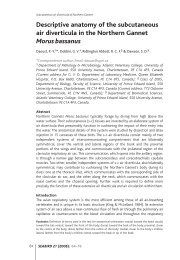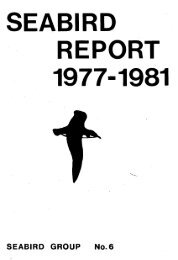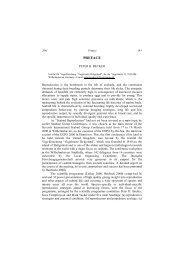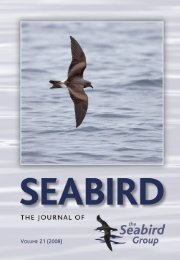Vol 6 No. 2 - The Seabird Group
Vol 6 No. 2 - The Seabird Group
Vol 6 No. 2 - The Seabird Group
Create successful ePaper yourself
Turn your PDF publications into a flip-book with our unique Google optimized e-Paper software.
2004 Diet of Mediterranean Gull 67<br />
September 2001 (470 adults, 7 juveniles and 5 subadults). <strong>The</strong> sample<br />
comprised altogether 2397 intact pellets, 1.33 to 3.92cm long, averaging 2.63<br />
cm ± 0.36, and 1.04 to 2.7 cm wide, averaging 1.64 cm ± 0.15 (n = 2,137 for<br />
measured pellets) plus disintegrated pellets. <strong>The</strong> flock of moulting gulls used the<br />
site for diurnal resting and did not spend the night there. Preparations for salt<br />
production in close proximity to the pan started in mid-August. <strong>The</strong>refore,<br />
irrespective of the growing number of birds in the flock, the amount of collected<br />
diet refuse decreased, because gulls were increasingly driven away by workers.<br />
Intact pellets remained in storage wrapped in paper until processing.<br />
Disintegrated pellets were combined into a sample from the respective<br />
collection date. <strong>The</strong> intact pellets were softened individually in water, rinsed<br />
with water through a thick-meshed sieve, and then dried. <strong>The</strong> combined sample<br />
of disintegrated pellets was processed in the same way. <strong>The</strong> seeds of wildgrowing<br />
plants were identified by comparison with the Collection of the Faculty<br />
of Biology and the University of Forestry in Sofia. Animal remains were<br />
determined by comparison with our comparative collections and the Collection<br />
of the National Museum of Natural History. Quantification procedures always<br />
followed the rule of minimum numbers. We present the numbers of animal<br />
groups in the summarised material of intact and disintegrated pellets, as well as<br />
the average number of individuals per pellet from the corresponding taxonomic<br />
category. Biomass is not reported owing to the very small amounts of animal<br />
parts as compared to vegetation in the pellets and inherent inability to determine<br />
the amount of seeds ingested.<br />
Stones and single pieces of glass consumed as gastroliths were counted<br />
and distributed into different categories: 1-5 pieces per pellet, 6-10 pieces, 11-20<br />
pieces and > 20 pieces. <strong>The</strong> amount of fragments from bivalve shells is not<br />
reported. Pellets with very small fragments are probably the remains after<br />
digestion of larger fragments. <strong>The</strong>ir counting out would not have given the<br />
actual number of swollen bivalve shells that took part in digestion. Various<br />
inorganic products, predominantly man-made, were also noted.<br />
<strong>The</strong> pellets fall into three groups, according to the degree of seed<br />
digestion: type A – completely digested seeds, or with small quantities of<br />
undigested fragments; type B – about half of the seeds in the pellet were<br />
digested to some extent, while the rest remained unchanged or slightly<br />
damaged; type C – most seeds remained visibly unchanged, or slightly<br />
damaged.<br />
<strong>The</strong> seeds visibly unchanged by digestion and having no traces of<br />
charring were tested for germination on moist cotton batting in Petri dishes at<br />
room temperature.








